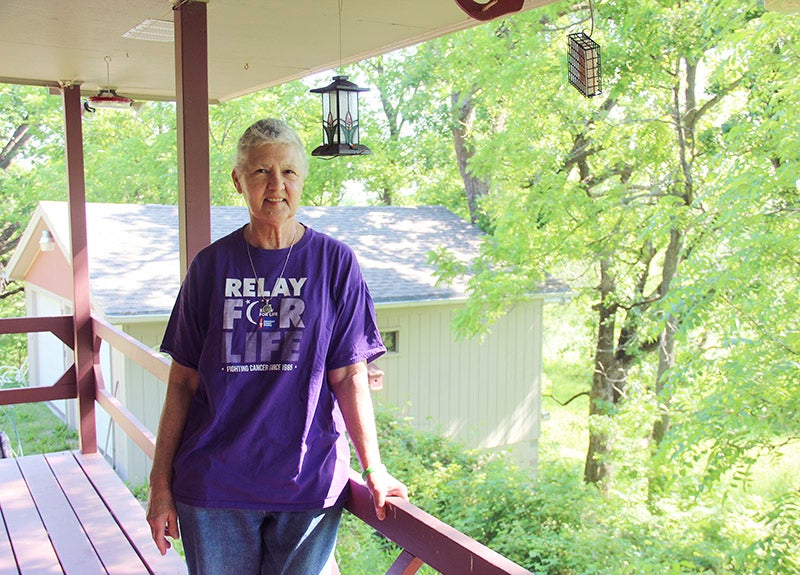Minn.’s sentencing guidelines affect Mower County’s criminal court system
Published 9:00 am Sunday, March 15, 2015
There’s a book inside Mower County Attorney Kristen Nelsen’s Office. At more than 2,000 pages, it’s a mammoth guide to Minnesota’s criminal law.
On a cold day in February, Nelsen had yet to update her copy (which she had received a few days before) with highlights, sticky notes and other quick references she needs on an every day basis.
“This is what we get every year,” Nelsen said.
It’s the book that helps lawyers decipher Minnesota’s criminal sentencing guidelines. The guidelines are simple, in theory: Two grids, one for regular crimes and one for sex crimes. The more crimes you commit, the more points you get. Larger crimes give you a larger chance at prison, based on what type of crime you commit.
That’s what the county attorney’s office works with every day. Minnesota’s sentencing guidelines are the complex framework in which our state’s criminal law is decided. The guidelines determine how people are punished for crimes they commit, and the state’s judicial system by and large abides by them.
‘Fairness and consistency’
The U.S. legal system today owes a huge debt to William Blackstone. An 18th century English scholar, Blackstone’s four-part work, “Commentaries on the Laws of England,” helped solidify England’s legal system and was a large influence on U.S. law.
It provided guidance to the English and to Americans, as before Blackstone, England’s court system produced wildly inconsistent punishments for similar cases.
Fast-forward a few hundred years to 1981, where Minnesota became the first state to create its own sentencing guidelines. Once again, state legal experts were looking to solidify criminal law and produce a clear set of rules for criminal punishments.
“It’s all about fairness and consistency, so that criminals aren’t getting unfair sentences based on geography, race, gender, and other factors,” Hennepin County District Judge Fred Karasov said. “Before that, there was a lot of disparity that had nothing to do with the offense.”
Karasov is among many attorneys and judges throughout the state who constantly read cases and updates from the Minnesota Sentencing Guidelines Commission, which examines and helps create the state’s guidelines. Last week, Karasov held classes for new judges on the state’s sentencing guidelines, but all trial judges come together about twice a year to get updates on sentences.
Mower County District Judge Kevin Siefken may be new to the bench — he was chosen to fill one of the county’s two judicial seats last summer — but he’s had plenty of experience as an attorney working with the guidelines.
“It’s a very different perspective,” he said. “As judges, we’re very bound by the guidelines, and as attorneys, we generally tried to get deviations from the guidelines. Not everybody realizes what it takes to deviate from the guidelines.”
It’s those deviations that come into play every day for the county attorney’s office. Nelsen and her five-attorney staff must figure out how severe a criminal’s punishment can be under the state’s guidelines, then figure how to proceed with the charges.
“It’s really simple,” Nelsen said. “It’s straight grid, offense, then score.”
A complex system
Yet the guidelines can complicate matters in the courtroom. Some residents don’t understand why certain criminals get probation for their crimes, and Nelsen said it’s difficult at times to explain to a family why, for instance, someone who stole from them will only serve probation based on their guidelines score.
“Some of these [crimes], they’re only punishable by three to five years in prison. We have to put that in the complaint, and that’s what gets put on” Nelsen said. “But they can’t get three to five years in prison, they have to get probation absent extraordinary circumstances.”
Residents don’t always understand how that works, and it can be difficult to reason why someone who committed a heinous crime is seemingly let off with a light sentence.
In February 2014, Nelsen and the Mower County District Court came under fire when Fox News Reporters and producers from Bill O’Reilly’s show, “The O’Reilly Factor,” took Nelsen to task over Gary Hegna, a 47-year-old accused of repeatedly having sex with a minor from the time she was 7 to 12 years old.
According to the court complaint, the victim said Gary Russell Hegna, 45, of Austin, forced her to have sex, made her wear costumes, watch pornographic movies and threatened to rape her if she didn’t comply.
Hegna was sentenced in January 2014 to 15 years’ supervised probation, which can result in three years of prison if he violates his probation terms.
O’Reilly and Fox analysts denounced the sentence, and Nelsen’s office, for alleged incompetence, but the truth was far more complex.
Hegna’s crimes allegedly began in 2006, which means prosecuting attorneys needed to work under the 2006 sentencing guidelines, for starters. The case never went to trial, as Hegna worked out a plea agreement to be charged with third-degree criminal sexual conduct in September 2013, which dropped a first-degree criminal sexual conduct charge from his case.
Nelsen and other Mower County attorneys won’t comment on pending cases — they don’t want “to reveal our playbook,” as Nelsen puts it — but oftentimes prosecuting attorneys work out plea agreements in part to spare victims from further trouble.
Nelsen and county attorney Jeremy Clinefelter recalled a case where an 8-year-old didn’t want to testify against her attacker, and was visibly upset at the thought of talking about the crime in court.
The county attorney’s office worked out a plea deal to spare her from testifying.
“Sometimes you have to protect the victim,” Nelsen said.
Working within the system
More often than not, prosecutors work out plea deals with criminals to ensure they’re punished within the state’s guidelines. A trial is always a risk, as sometimes victims or witnesses won’t testify and back up evidence, but an agreement ensures criminals will be punished in some way.
Plea agreements also put longtime criminals behind bars.
Luke Dale Freland, 32, of Austin, was charged in December for allegedly fracturing an infant’s ribs and assaulting a woman, among other crimes.
According to a court complaint, Freland and the adult victim argued during the morning of Dec. 17 when Freland pushed or pinched the infant’s throat to get him to stop crying.
Freland and the woman argued for a while more before he got up and threw her to the floor, where he grabbed her throat and covered her mouth. Freland told the victim to stop crying “or I will keep doing it until you pass out and no on can hear you,” according to the complaint. At one point, Freland grabbed a knife and told the victim to get back upstairs or else he would slit her throat.
He allegedly dragged the victim upstairs by her hair and prevented her from going outside to a balcony to yell for help, according to the complaint.
Freland dragged her to the bathroom and put her in a headlock. He took the victim’s cell phone and left the house at that point.
The victim reported the incident to the police and was taken to Mayo Clinic Health System in Austin, along with the infant. According to the complaint, the victim told hospital staff Freland would allegedly squeeze the infant, throw him into the air and push or pinch his neck to get him to stop crying. Medical staff noted multiple bruises on the infant’s arms, legs, body, sides and abdomen and transported him to Mayo Clinic Rochester — St. Marys Campus, where he underwent a CT scan. Doctors found the infant’s fifth and sixth ribs were fractured in what they classified as “non-accidental trauma.”
He was charged with six counts including second-degree assault, terroristic threats, malicious punishment of a child and domestic assault. Freland was further charged in January with five felony counts of violating an order for protection against the victim and five counts of domestic abuse for violating a no-contact order when he tried numerous times to contact her from prison.
During several of the calls, Freland told the victim to ask the court and his attorneys to drop the charges and claim everything had been fine between the two. Once that was done, Freland allegedly told the victim the most serious charges would be dropped and “Boom, I’m outta here! You know what I mean?” according to the complaint.
Under the state’s sentencing guidelines, Freland could have gotten off lightly. He had a criminal history 17 to 20 misdemeanors in Minnesota, and his one felony was a fifth-degree charge. That added up to only one and a half points, which isn’t much considering the state’s guidelines grid outlines punishments for up to six points.
What’s more, the state tends to round down to one point whenever half points occur.
Freland’s charges — including numerous felonies — would add up to three points, in part because Freland committed further crimes while his first case was pending in court. Though Freland’s criminal history score was weak, he could have faced up to 33 months in prison.
Under the terms of his agreement, Freland pleaded guilty on Feb. 9 to one count each of felony domestic assault and malicious punishment of a child under 4 years of age, and one count of violating a no-contact order, all of which are felonies. He could face about 21 months in prison once he’s sentenced under state guidelines.
What’s more, Freland’s criminal history now reflects further felonies, which increases his likelihood of prison time in the future. More important, by pleading guilty and getting convicted, Freland will lose his parental rights to the infant.
“It will be automatically successful in terminating his parental rights,” Clinefelter said. “Guaranteed, they don’t have to testify, and we won’t risk a poor result at trial, which happens.”
In the grid
Sentences can often be complicated. Judges must make decisions based on presentence investigations, which help determine how a person is punished. Sentences can differ for each seemingly small factor — whether someone willfully committed a crime, whether they used a weapon, how a crime was committed.
“There’s a lot of detail that goes in,” Siefken said. “It gets pretty complex.”
Yet the guidelines are there to make punishments fair across the board, though critics point out Minnesota’s disproportionate punishments in some areas, such as child pornography charges.
The guidelines are still complex, and continuously challenged. The state’s Sentencing Guidelines Commission is recommending harsher punishments for gun-related crimes to the Legislature this year, for example.
That doesn’t mean people won’t get upset when local criminals are sentenced, however. For example, former Pacelli teacher Mary Gilles is likely to get probation under state guidelines when she is sentenced later this spring for having sex with a 17-year-old.
Gilles, 28, faced six counts of third-degree criminal sexual conduct after she was accused of sleeping with one of her students several times in 2014. She pleaded guilty to two of those six counts in December.
Those sentences are part of the job for Nelsen and the county attorney’s office. Yet Nelsen hopes more residents will take the time to understand the state’s sentencing guidelines before rushing too quickly to judgment on whether a criminal deserved to go to jail.
“That’s what I think the public doesn’t understand a lot,” Nelsen said. “We can think they’re the baddest guy and done the worst things, but if it doesn’t fit on that grid where we want it to, then we can’t do it.”





